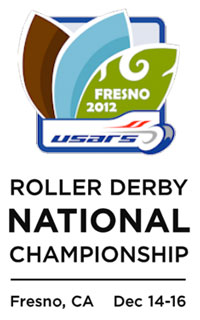Welcome WRDN’s look-back at the 2013 WFTDA playoff season! Your intrepid commentator will opine on four different items in four separate posts, creating a snapshot of what the WFTDA has been doing right, what it has been doing wrong, and what it’s flat-out not doing. This is part two. (Part one is here.)

Time to go under the hood on WFTDA official reviews.
It’s time we start giving referees a break.
Watching the playoffs from home, looking at the reactions of crowds and skaters, and seeing a lot of feedback online, I got the sense that the ref crews at the WFTDA playoffs, particularly those at WFTDA Championships, took a lot of heat for calls, non-calls, questionable calls, close calls, and calls that were extremely unpopular—but ultimately correct.
Granted, there were some calls that were very boo-worthy. A few insubordination calls for failing to immediately leave the track after a penalty call were probably unnecessary. There was also the rare moment when an officiating error was flat-out bad, such as the 2-minute overtime jam that only lasted one minute, called off too quickly by an (apologetic) jam timer NSO.
But with the number of games, the number of jams, and the number of total events referees needed to judge throughout the WFTDA playoff season, the fact that they got so, so much of it right should be commended. Particularly, since they need to wrestle with the complexity of the WFTDA rule book just as much as the skaters who wrote it.
In the few instances when a referee crew was incorrect on a critical assessment, the rules allow a team to use an official review to make their case to the officials to see about overturning the call as it was originally made. The rules and officiating of them are still a work in progress, so allowing skaters to point out a clearly-wrong call to the officials is important to make sure it does not unfairly swing the outcome of a game.
However, a discouraging trend among skaters and teams appeared during the tournament season, with regards to the official review system.
A lot of teams requested official reviews that seemed dubious themselves, requesting that referees stop the game to try and overturn calls that were obviously correct in the first place, or ask the referees to issue a penalty to an opponent that clearly did not happen.
At the time of their request, they seemed like simple uses of the review system. But two of them revealed an underlying motivation for their use, one that was inconsistent with the spirit of the rules and one should be stopped before it gets out of hand.
– – – – – – – – – –
The first is from the Texas-Gotham championship final.
With 6 minutes left in the first half, Olivia Shootin’ John and Bonnie Thunders take to the jammer line. Both get out of the pack quickly, but LeBronnie eats the baby on OJ, eventually causing the Texas jammer to commit a cutting penalty.
Gotham goes on the power jam, and after two snoring passes—sorry, scoring passes—of passive offense, the Texas 3-wall finally manages to shove their mark out of bounds at turn 4, recycling everyone back into the awaiting Gotham rear wall.
The three Gotham blockers try to hold Texas from recycling Bonnie all the way behind the pack, but a Texas blocker finds an open lane. Just as she starts moving clockwise behind the Gotham rear wall, Bonnie starts moving in the derby direction and re-enters behind her.
From most angles, this was a close re-entry. The crowd saw Bonnie cut the Texas blocker and demanded a penalty, as is what crowds tend to do when a call does not go the way of the popular underdog. The refs saw a legal re-entry by Bonnie and went about their business, as is what referees tend do when there is no penalty to call. Bonnie saw 20 points go up on the scoreboard, as is what Bonnie tends to do when she is on the power jam.
Texas, on the other hand, thought that the crowd was right and the referees were wrong. After the jam, they asked for an official review of the non-call on the alleged cut committed by Bonnie during the sequence, figuring Gotham deserved to be down a jammer—and they were owed a power jam. Continue reading →
Let your friends know about this post:



 It’s a good news, bad news situation for USA Roller Sports Roller Derby.
It’s a good news, bad news situation for USA Roller Sports Roller Derby.
 Roller derby history was made this past weekend. Although, exactly what kind of history will take a few years to fully figure out.
Roller derby history was made this past weekend. Although, exactly what kind of history will take a few years to fully figure out.



18 Aug
RollerCon 2014 Video Diaries: USARS Roller Derby
Posted by WindyMan in Commentary. Tagged: USARS. Leave a comment
Let’s talk about USARS for a moment.
In its decision to start its own roller derby program and develop its own roller derby rule set, in spite of the great work done by the WFTDA and MRDA, USA Roller Sports has been met with much criticism from the greater roller derby community.
In the past, this criticism was justified. With horror stories of skater insurance claims gone awry all the way up to the overreaching issue of poor management that nearly killed off roller sports as a whole—only to start making a comeback thanks to the WFTDA—one would be forgiven in assuming that USARS is only continuing their ways today.
So it would seem still. This year, USARS canceled its three roller derby regional qualifier tournaments, opting instead to hold a single, open national championship for women’s and co-ed teams in northern California next month. Additionally, it was revealed in public USARS board meeting minutes that some kind of legal action may eventually take place against the currently-existing Team USA Roller Derby (both of them) for unauthorized use of the “Team USA” name, a name that will soon adorn USARS’ own national-select team.
No wonder some accuse USARS of “riding on the coattails” of the roller derby community!
However, much of the criticism directed at USARS seems to be ignoring one very important thing. Roller derby is supposed to be for the skaters, right? What, then, about USARS skaters? What do they think about USARS, and the style of roller derby it is going out of its way to attempt to develop and promote?
As it turns out, skaters who skate USARS absolutely love it. And despite the growing pains of USARS Roller Derby’s first three years, many were still enthusiastic about having a new roller derby option that’s hard, fast, competitive, and fun.
After the USARS showcase game at RollerCon, I spoke with USARS Roller Derby Coordinator AJ Epp about the Team USA controversy (USARS cannot and does not want to shut down the existing Team USA, but the U.S. Olympic Committee and its governing bodies has exclusive rights to the trademark), the cancellation of its regional tournament season (biggest complaint: Teams lamented a missed chance to get some “good, hard games” in before nationals), and the ultimate goal of USARS and its roller derby program.
I then spoke with skaters about what they like about USARS derby and their comments on the stigma surrounding the organization. Inevitably, comparisons between playing USARS rules and WFTDA rules were made by the skaters. Seeing that almost all of them are affiliated with WFTDA leagues and play both USARS and WFTDA regularly, they are the best suited to make those comparisons, as well as clear up some fallacies about the USARS game. (Fallacies often made by those that don’t skate it, it should be pointed out.)
Along the way, I talked with some curious RollerCon attendees to get their impressions after seeing USARS derby for the very first time, and whether or not they’d want to try it themselves. Judging by their responses, as well as from the small, but slowly growing number of USARS leagues and club teams across the country (and around the world), it seems as if once they have seen it and once they have tried it, they want to keep seeing it and keep playing it, because they like it.
If an organization, however flawed, wants to give skaters the option to play roller derby in the way they want to play it, no matter how few or how many skaters they are, maybe that’s something worth supporting after all.
Let your friends know about this post: